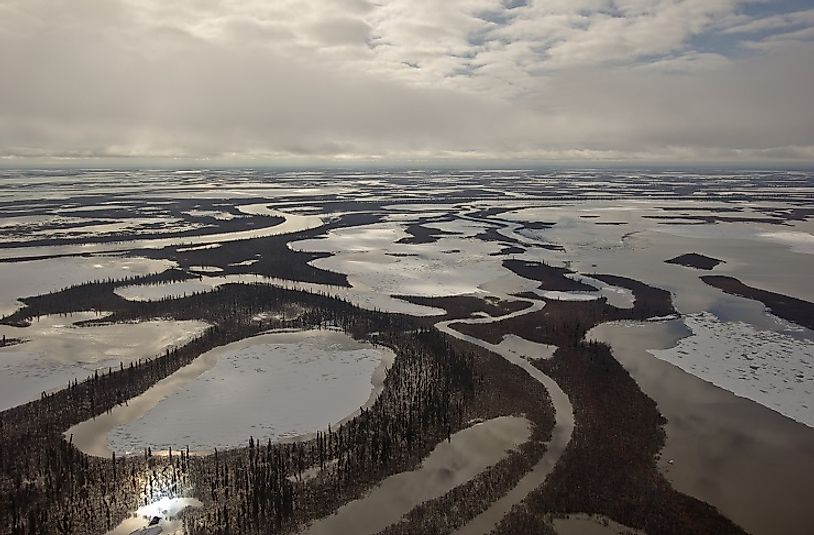Where is the Mackenzie River?

5. Description
The Mackenzie River system is the second largest river system in the North American continent, after only the Mississippi-Missouri River system. It is also Canada’s largest and longest river basin. The Mackenzie River system flows along a course of 4,241 kilometers from its headwaters in the Finlay River to its drainage into the Beaufort Sea in the Arctic Ocean. The Mackenzie and its tributaries together drain an area of about 1,805,200 square kilometers, which represents about 20% of Canada’s total land area. Though the Mackenzie River itself flows entirely within the boundaries of the Northwest Territories of Canada, many of its tributaries spread out into adjacent Canadian provinces, such as British Columbia, Saskatchewan, Alberta and Yukon. The Peace, Athabasca, and Liard Rivers are some of the most important tributaries of the Mackenzie. A number of lakes, like the Lake Athabasca, Great Slave Lake, and Great Bear Lake, also form notable parts of the Mackenzie River system.
4. Historical Role
The Mackenzie River basin was used as an important trade route by European fur traders since the late 18th Century. The river was named after the Scottish explorer Alexander Mackenzie, who explored the river and traveled along its course to reach the Arctic Ocean in 1789. Soon thereafter, a large number of trade posts cropped up along the river and its tributaries, and York boats began to ply on the river in the early 19th Century. These boats were gradually replaced by steamboats, and the fur trade soon flourished along the river. In the early parts of the 20th Century, mining became another economically significant activity around the Mackenzie River Basin, though in the later half of the 20th Century, profits garnered from mining activities there became marginal at best.
3. Modern Significance
The Mackenzie River basin is still one of the most sparsely populated, and pristine, habitats of North America. Through the trapping of animals such as beavers, lynxes, foxes, and martens for fur is still practiced by the indigenous Indians settled along the river, fur trading is no longer a dominant source of economic revenue for this region. Agriculture is not extensively practiced in this region, and is mainly limited to the warmer, southern reaches of the river and its tributaries, where grains and cereals are cultivated and animal ranching is practiced. Commercial fishing is carried out in the lakes of the Mackenzie system like Lake Athabasca and the Great Slave Lake. Oil and petroleum mining is the major profitable activity along the Mackenzie River, with the first oil field being discovered in 1921 at Norman Wells. Uranium, gold, diamond, lead, and zinc have also been mined in and along the Mackenzie River system. Besides its economic significance, the Mackenzie River is also ecologically significant, hosting some of the most pristine habitats of North America, and accounting for 11% of the freshwater entering into the Arctic, thereby influencing the circulation patterns of this northern ocean to a significant degree.
2. Habitat
The Mackenzie River flows through a Boreal forest zone in the south, then into an extensive taiga vegetation zone in its middle reaches, and finally drains into the Arctic Ocean via the Arctic tundra zone in its northernmost reaches. Alders, Trembling aspens, birches, Balsam firs, and spruces are some of the important plant species of the Taiga forests along the Mackenzie River system. Further north, cottongrass, feather-moss, bog cranberry, and sphagnum moss cover the landscape along the river basin. The caribou, lynxes, minks, beavers, and muskrats are some of the mammalian species inhabiting the taiga forests along the Mackenzie. Beluga whales can often be spotted in the Mackenzie River Delta, while Mountain whitefish, Northern pike, minnows, Chinook salmon, Cutthroat trout, and other fish species thrive in the waters throughout the Mackenzie River system. The Osprey, geese, Sandhill cranes, Tundra swans, and other spectacular birds populate the watershed wetlands of the Mackenzie River system as well.
1. Threats and Disputes
Even though a lot of effort goes into conserving the Mackenzie River Basin, a large number of ongoing problems threaten the river today. One of the major sources of pollution of these river waters involves the production of oil-sands along the river, which in turn produce toxic byproducts composed of mercury, arsenic, lead, and benzene. The water levels in the Mackenzie River system has also been drastically altered by large-scale damming activities along the tributaries and headwaters of the Mackenzie. This has adversely affected the life-cycle of a large number of aquatic fish species. Besides damming, climate change has also triggered changes in the hydrology of the Mackenzie River, affecting its waters' flows into the Arctic Ocean. If this trend continues, it could lead to a transformation in the ocean current patterns of the Arctic, consequently affecting climates and ecosystems worldwide.







